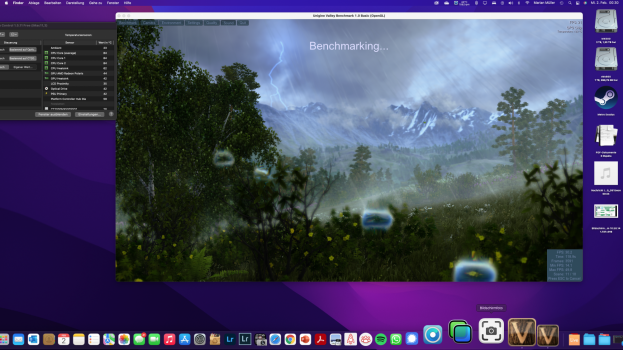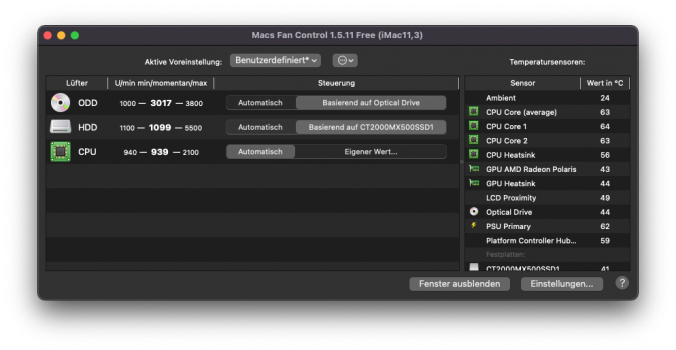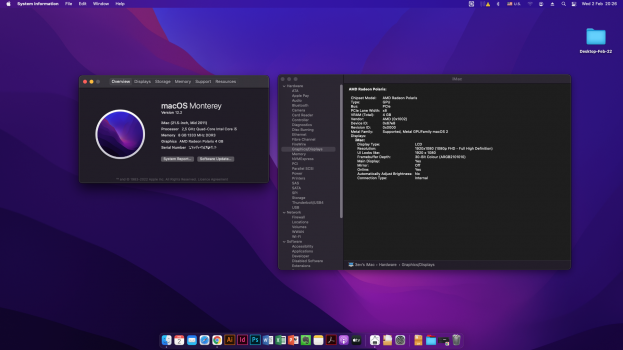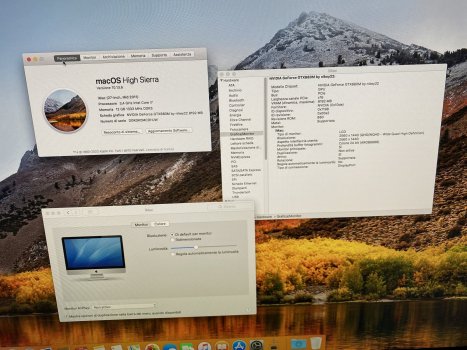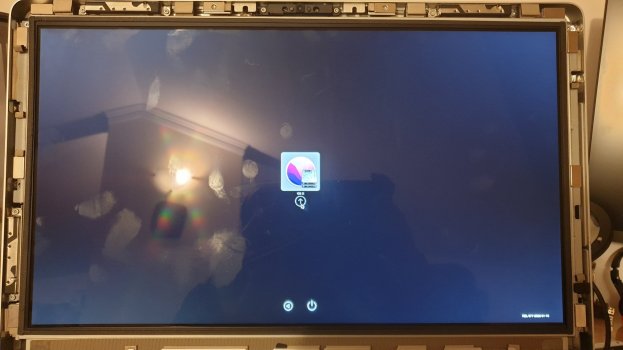I think this is looking far better now! The GPU core temp was never above 50 degrees celsius in this Valley test. Before I had +80 degrees and huge difference between ODD and heatsink GPU. Thank you su much for the advice! Maybe this was the reason for the random black screens (I really hope so...). 🙌Check your mount again - do you have a copper shim between the GPU die and the heatsink with thermal paste on both sides?
A temperature difference of nearly 40 degrees between GPU die and heatsink is (very) worrying. I never observed a temp. difference of more that 10 degrees with WX4130/WX4150/WX4170 under continued full load - it was more like 5-6 degrees (even with the measly heatsink in 21.5’ machines).
Got a tip for us?
Let us know
Become a MacRumors Supporter for $50/year with no ads, ability to filter front page stories, and private forums.
iM 4,1-14,4 2011 iMac Graphics Card Upgrade
- Thread starter MichaelDT
- WikiPost WikiPost
- Start date
- Sort by reaction score
You are using an out of date browser. It may not display this or other websites correctly.
You should upgrade or use an alternative browser.
You should upgrade or use an alternative browser.
- Status
- The first post of this thread is a WikiPost and can be edited by anyone with the appropiate permissions. Your edits will be public.
You try to connect an iMac11,1 to an iMac12,2 using a Thunderbolt cable?Also, any reason on why does a 2011 27 imac with an wx4130 cant output video through the thunderbolt ports? I have bot a thunderbolt 2 cable connected to a 27 2009 i7 and when I'm pressing cmd f2 nothing happends
This is expected and works as designed.
A mini DisplayPort cable is needed for target display mode to work. A thunderbolt cable will not function correctly.Also, any reason on why does a 2011 27 imac with an wx4130 cant output video through the thunderbolt ports? I have bot a thunderbolt 2 cable connected to a 27 2009 i7 and when I'm pressing cmd f2 nothing happends
@m0bil : great the patched nvflash worked to override the board ID - I had to try out several times and finally type y and YES under a dark screen, but the new rom (see list on page 1) finally was written on the GTX680M - unfortunately it worked just 25%. On High Sierra "screen fragments" I could find under "About this MAC" "GTX680M by @nikey22 1024MB ?! (Originally it is a 4GB version gpu... as proofed under UBUNTU) so I easily flashed it back to the backup original rom (seeing that time what I was typing in).The PCI Subsytem ID difference can be changed with the "-6" option to nvflash. The problem here is the different Board ID:
ERROR: Board ID mismatch
If "--protectoff" does not work, you can try a patched nvflash to override this, there is one available for windows here.
If you already have linux, I posted here a patched nvflash that will bypass certificate check, but I don't know if it will override board ID mismatch, maybe it's worth a try. Use options "--protectoff" first and then "-6" when trying to flash rom.
If none of this works, it is possible to change Board ID on the vbios file to match you board id.
Also take into account that this kind of changes can lead to card not working (recoverable by hardware programming the eeprom back to your original contents), so make sure to have a backup of you eeprom.
I had an extra SSD booting with Windows 10 the card is recognized here as 2GB .... herewith I was able to run GPU-Z and the patched nvflash.
I will do a very last trial tonight to see if a GTX780M rom will bring back a full or better ios performance.
Otherwise I learned a lot and now I have a linux / Windows 10 imac 2011.
By the way the GPU GTX680M shows up as MSI version - so maybe this is the rootcause for the issues.
Anyway thanks again!
A different Board ID usually means there are hardware differences in boards (like cards with different memory configurations), so it's not unexpected that the available rom does not work in your card. Most probably your card has a memory type or configuration not supported by the actual GTX680M rom.@m0bil : great the patched nvflash worked to override the board ID - I had to try out several times and finally type y and YES under a dark screen, but the new rom (see list on page 1) finally was written on the GTX680M - unfortunately it worked just 25%. On High Sierra "screen fragments" I could find under "About this MAC" "GTX680M by @nikey22 1024MB ?! (Originally it is a 4GB version gpu... as proofed under UBUNTU) so I easily flashed it back to the backup original rom (seeing that time what I was typing in).
I had an extra SSD booting with Windows 10 the card is recognized here as 2GB .... herewith I was able to run GPU-Z and the patched nvflash.
I will do a very last trial tonight to see if a GTX780M rom will bring back a full or better ios performance.
Otherwise I learned a lot and now I have a linux / Windows 10 imac 2011.
By the way the GPU GTX680M shows up as MSI version - so maybe this is the rootcause for the issues.
Anyway thanks again!
For reference, can you please post the rom that came with your card, and a picture of memory chips?
Last edited:
Check also odd fan speed, correct airflow, and heatsink. It's normal that you notice the difference under load, but there's definitely something wrong, the difference should not be more that 10ºC at most.just checked it, it has a 1mm copper plate with thermal paste on both sides, I don't understand why idle temps are normal but when under load it get so excesively hot and the 2 sensors are reporting such contrasting values
I just upgraded my mid-2011 21,5 imac to the wx4150 and Monterey (from High Sierra).
It was a nightmare yesterday, nothing was working, I couldn't get the OC boot picker to show. I installed OCLP on usb, cd and internal drive efi and none of these worked. I flashed the card with WX4150_GOP.rom then with the ALT_VRAM GOP rom - nothing. No internal display, no external, just the remote desktop was working.
So, no boot picker - it was going directly to the apple loader and at the end of the loader black screen. Booting from EFI with OC on USB and SD - black screen.
Today while plug-in / unplugin the cable to the external monitor my main screen miraculously showed.
I had the 12.2 installer downloaded already with OCLP on my computer, opened it and it installed Monterey for about 30min.
The system is fluid and fast, sleep works.
2 things don't work - wifi (can not find networks) and the external monitor on the mini display port.
This leads to my question:
What kexts should I install to get those working?
If the system managed to update without OC it is better to keep it vanilla and just add 2-3 kexts instead of using OC, right?
Edit: I was actually booting from OC on the internal drive. On High Sierra the system was booting with black screen (only remote desktop worked) and after the upgrade the internal screen works fine.
It was a nightmare yesterday, nothing was working, I couldn't get the OC boot picker to show. I installed OCLP on usb, cd and internal drive efi and none of these worked. I flashed the card with WX4150_GOP.rom then with the ALT_VRAM GOP rom - nothing. No internal display, no external, just the remote desktop was working.
So, no boot picker - it was going directly to the apple loader and at the end of the loader black screen. Booting from EFI with OC on USB and SD - black screen.
Today while plug-in / unplugin the cable to the external monitor my main screen miraculously showed.
I had the 12.2 installer downloaded already with OCLP on my computer, opened it and it installed Monterey for about 30min.
The system is fluid and fast, sleep works.
2 things don't work - wifi (can not find networks) and the external monitor on the mini display port.
This leads to my question:
What kexts should I install to get those working?
If the system managed to update without OC it is better to keep it vanilla and just add 2-3 kexts instead of using OC, right?
Edit: I was actually booting from OC on the internal drive. On High Sierra the system was booting with black screen (only remote desktop worked) and after the upgrade the internal screen works fine.
Attachments
Last edited:
Thank you very much @nikey22 and @Ausdauersportler for all the help
Finally there is the gtx880m installed and fully functional!!!!!!!!!!!!
One last question to have windows 10 or 11 in dual boot what should I do? Can I do this with the osx assistant or is there another way?
Thanks too much
Finally there is the gtx880m installed and fully functional!!!!!!!!!!!!
One last question to have windows 10 or 11 in dual boot what should I do? Can I do this with the osx assistant or is there another way?
Thanks too much
Attachments
Sorry I am not able to attach the rom file (it turns to .doc)?? Anyway on page 6 (2015) there is a similar experience. But this was far before all that flashes... I tried some GTX780M roms but nothing worked - so I got the gpu out and reassembled the imac with an old 1GB original GPU .... Lets wait for another GTX780mA different Board ID usually means there are hardware differences in boards (like cards with different memory configurations), so it's not unexpected that the available rom does not work in your card. Most probably your card has a memory type or configuration not supported by the actual GTX680M rom.
For reference, can you please post the rom that came with your card, and a picture of memory chips?


If you have OCLP build four machine wireless lan will be patched automatically. You need to enter SSID and password manually in your network settingsI just upgraded my mid-2011 21,5 imac to the wx4150 and Monterey (from High Sierra).
It was a nightmare yesterday, nothing was working, I couldn't get the OC boot picker to show. I installed OCLP on usb, cd and internal drive efi and none of these worked. I flashed the card with WX4150_GOP.rom then with the ALT_VRAM GOP rom - nothing. No internal display, no external, just the remote desktop was working.
So, no boot picker - it was going directly to the apple loader and at the end of the loader black screen. Booting from EFI with OC on USB and SD - black screen.
Today while plug-in / unplugin the cable to the external monitor my main screen miraculously showed.
I had the 12.2 installer downloaded already with OCLP on my computer, opened it and it installed Monterey for about 30min.
The system is fluid and fast, sleep works.
2 things don't work - wifi (can not find networks) and the external monitor on the mini display port.
This leads to my question:
What kexts should I install to get those working?
If the system managed to update without OC it is better to keep it vanilla and just add 2-3 kexts instead of using OC, right?
Edit: sorry … I meant apply the „Post installation patches“ with OCLP in order to activate legacy wlan
Last edited:
Nope, entering manually the SSID/pass didnt work in my case. "Network not found"If you have OCLP build four machine wireless lan will be patched automatically. You need to enter SSID and password manually in your network settings
I'll probably buy new compatible card.
If you have OCLP build four machine wireless lan will be patched automatically. You need to enter SSID and password manually in your network settings
Edit: sorry … I meant apply the „Post installation patches“ with OCLP in order to activate legacy wlan
Errr … sorry … I meant apply the „Post installation patches“ with OCLP in order to activate legacy wlanNope, entering manually the SSID/pass didnt work in my case. "Network not found"
I'll probably buy new compatible card.
Thanks, I'll try itErrr … sorry … I meant apply the „Post installation patches“ with OCLP in order to activate legacy wlan
Monterey wouldn't boot without OpenCore, I think. I'm quite sure you're actually booting using OpenCore.What kexts should I install to get those working?
If the system managed to update without OC it is better to keep it vanilla and just add 2-3 kexts instead of using OC, right?
Could be. I installed it also on the internal drive. All this was quite confusing. If it is on the internal drive is there any OC boot picker or it boots directly the OS?Monterey wouldn't boot without OpenCore, I think. I'm quite sure you're actually booting using OpenCore.
There is a boot picker, but it will continue booting automatically after ~2s.Could be. I installed it also on the internal drive. All this was quite confusing. If it is on the internal drive is there any OC boot picker or it boots directly the OS?
The picker should show on your screen, though. (And there's no way to get the Apple boot picker.)
Something affecting only 21.5" iMacs, maybe?
Is this the OC picker? If it is, it means I boot from OC. On the pictures I checked for OC picker there were additional options.There is a boot picker, but it will continue booting automatically after ~2s.
The picker should show on your screen, though. (And there's no way to get the Apple boot picker.)
Something affecting only 21.5" iMacs, maybe?
Attachments
Last edited:
Yes, this OC book picker. It shows you internal and external drives like USB or SD drive. After a few seconds it should boot into Monterey .Is this the OC picker? If it is, it means I boot from OC. On the pictures I checked for OC picker there were additional options.
Yes, I edited my 1st post. I was booting from OC on the internal drive. @internetzel do you know how to enable the mini DisplayPort or any hints where to look? This is the only thing not working yet.Monterey wouldn't boot without OpenCore, I think. I'm quite sure you're actually booting using OpenCore.
Do I have just to change the model identifier and which one to pick closest ti imac12,1 in order to get mDP working?
Last edited:
I see, according to memory chips and gpu-z you've got the 2GB version of the 680M.Sorry I am not able to attach the rom file (it turns to .doc)?? Anyway on page 6 (2015) there is a similar experience. But this was far before all that flashes... I tried some GTX780M roms but nothing worked - so I got the gpu out and reassembled the imac with an old 1GB original GPU .... Lets wait for another GTX780m
View attachment 1953305
View attachment 1953291
There are 4GB and 2GB versions of this card, probably with different Board ID. Maybe @nikey22 vbios only works on the 4GB version of this card. Another possibility is that since you card has Hynix BFR memory (there are AFR and BFR Hynix memory chips) it is not supported by the vbios (this is a problem that has already happened on other Nvidia cards).
I'm baaaaaack!!
Now I have to have a USB drive with Big Sur on it. Per Page 1, I downloaded the OCLP 0.4.1 and ran it as they instruct. NICE job, thank you, to anyone involved with it. Everything I saw is exactly what the instructions said I should see. Once I started the Install MacOS Big Sur I get the accept license, then try to select the USB drive on which to install it but it's grayed-out and if I try and click it I get a message that says "disc is locked". Huh? I checked the formatting in Disk Utility: GUID partition map, Mac OS Extended (Journaled). Here's a screen shot:

You can see that the Installer is on the USB. I have NO idea what to do for "disc is locked".

I did a search on this thread and didn't find anything. I double-checked that it's the GUID partition map, but since the OCLP formatted the USB for me I presume it did so correctly.
HELP!!!!
LOVE the OCLP scheme otherwise. I did it the old, hard way last year and this is a huge improvement!
Thanks for any assistance you can offer.
Now I have to have a USB drive with Big Sur on it. Per Page 1, I downloaded the OCLP 0.4.1 and ran it as they instruct. NICE job, thank you, to anyone involved with it. Everything I saw is exactly what the instructions said I should see. Once I started the Install MacOS Big Sur I get the accept license, then try to select the USB drive on which to install it but it's grayed-out and if I try and click it I get a message that says "disc is locked". Huh? I checked the formatting in Disk Utility: GUID partition map, Mac OS Extended (Journaled). Here's a screen shot:
You can see that the Installer is on the USB. I have NO idea what to do for "disc is locked".
I did a search on this thread and didn't find anything. I double-checked that it's the GUID partition map, but since the OCLP formatted the USB for me I presume it did so correctly.
HELP!!!!
LOVE the OCLP scheme otherwise. I did it the old, hard way last year and this is a huge improvement!
Thanks for any assistance you can offer.
Last edited:
Short question, which may lead you to the obvious solution yourself:I'm baaaaaack!!
Now I have to have a USB drive with Big Sur on it. Per Page 1, I downloaded the OCLP 0.4.1 and ran it as they instruct. NICE job, thank you, to anyone involved with it. Everything I saw is exactly what the instructions said I should see. Once I started the Install MacOS Big Sur I get the accept license, then try to select the USB drive on which to install it but it's grayed-out and if I try and click it I get a message that says "disc is locked". Huh? I checked the formatting in Disk Utility: GUID partition map, Mac OS Extended (Journaled). Here's a screen shot:
View attachment 1953548
You can see that the Installer is on the USB. I have NO idea what to do for "disc is locked".
View attachment 1953572
I did a search on this thread and didn't find anything. I double-checked that it's the GUID partition map, but since the OCLP formatted the USB for me I presume it did so correctly.
HELP!!!!
LOVE the OCLP scheme otherwise. I did it the old, hard way last year and this is a huge improvement!
Thanks for any assistance you can offer.
Which is the source of your installation and which will be the destination of the installation?
Nice to hear from you again! I hope you're well and having some fun.
To answer your question, the destination is the USB drive but I don't know what the source is! With the GUI, as you know well, you simply make the selections and the OCLP interface does whatever it does. I make the same selections as outlined in the OCLP instructions. But I can see that I have the BigSur installer on "Macintosh HD" (my HS internal disc) and in the picture above you can see the MacOS Install on the USB drive. In case it helps, here is the full installer log:
 www.dropbox.com
Maybe I'm mis-understanding something in the OCLP instructions but, if so, I have no idea what it is as I followed all the steps.
www.dropbox.com
Maybe I'm mis-understanding something in the OCLP instructions but, if so, I have no idea what it is as I followed all the steps.
Thanks for still being around and helping us numpties!😀😀😀
To answer your question, the destination is the USB drive but I don't know what the source is! With the GUI, as you know well, you simply make the selections and the OCLP interface does whatever it does. I make the same selections as outlined in the OCLP instructions. But I can see that I have the BigSur installer on "Macintosh HD" (my HS internal disc) and in the picture above you can see the MacOS Install on the USB drive. In case it helps, here is the full installer log:
Dropbox - Error - Simplify your life
Thanks for still being around and helping us numpties!😀😀😀
The source is your USB drive! You cannot install macOS on source installation media. Either prepare another installation media on a USB stick or install on another drive (internal or external).Nice to hear from you again! I hope you're well and having some fun.
To answer your question, the destination is the USB drive but I don't know what the source is! With the GUI, as you know well, you simply make the selections and the OCLP interface does whatever it does. I make the same selections as outlined in the OCLP instructions. But I can see that I have the BigSur installer on "Macintosh HD" (my HS internal disc) and in the picture above you can see the MacOS Install on the USB drive. In case it helps, here is the full installer log:
Maybe I'm mis-understanding something in the OCLP instructions but, if so, I have no idea what it is as I followed all the steps.Dropbox - Error - Simplify your life
www.dropbox.com
Thanks for still being around and helping us numpties!😀😀😀
Register on MacRumors! This sidebar will go away, and you'll see fewer ads.


